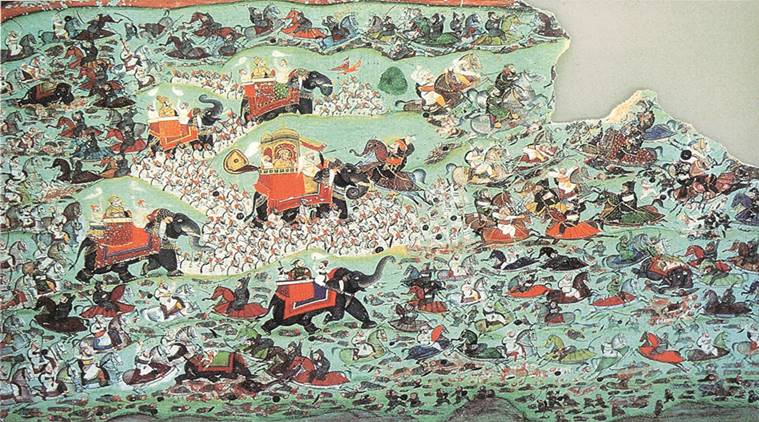Or “This is why we can’t have nice things”

On the last episode of “Abhisutra”, our author was preparing to complain endlessly like the little nerd goblin he is about every single Star Wars movie in sequential order. After launching the first salvo of nerd rage, he braced for impact with the legendary terrible “Episode 2: Attack of the Clones”, yet he (and everyone around) were saved from the traumatic experience by nothing less than a plane! A plane that carried him off to Germany and then the United States, where he soon found himself in the middle of a renaissance fair!
Yes, I fled the (voluntary) duty of watching Episode 2 to the land of FREEDOM. There were some important things I had to do here, but perhaps the most important one was the Bristol Renaissance Faire. I’d grown up hearing about such events, and being a huge fan of both history and the fantasy genre, it seemed only right that I hop across the world and check it out.
Suffice to say, it was great! Lot’s of fun sights, sounds, and most importantly, really cool folk.
Oh, and swords. LOTS OF SWORDS.

Amusingly, there were a ton of shops selling Indian artifacts, as well as a few visitors dressed in Indian clothing! This got me thinking about how such a fair might look in India itself. The first notion was “it would be awesome!”, which it would. Yet immediately, I also began wondering about what an uphill challenge would it be to even get such a thing started back home.
No Fantasy in the Mystical East
I can already hear the crowds screaming as they glare at my decleration. “India has such a rich culture and history! Of course we can do Renissance Fairs!”

Yes, we do have (several) rich culture(s), and yes, the sum total of our medieval history could probably make Europe’s shifting empires of knights and lords look like small scale gang warfare, yet paradoxically, therein lies the problem. We have rich cultures, some of which have ongoing problems with each other. We have a rich history, in which many conflicts remain unresolved or outright ignored in the name of politeness. We have a rising genre of fantasy fiction, but too many times it draws far too directly from one of the many religions in the country instead of creating new worlds that anyone can delve into.
All of the above are, as you might imagine, far more complicated issues than a single sentence summary can do justice to. So, let’s pick some of them apart.
My god beats your god!
India is rightly famous for being the hub of possibly hundreds of religions. Every major faith in the world has a presence in the subcontinent, and even some of the more obscure and ancient creeds can be found in communities living side by side with Hindu’s, Muslims and Christians. Generally speaking, everyone gets along splendidly too.
Except when they don’t.
Sectarian violence has been coming into the public conscience more and more in the west, but a sad truth is that India has had to deal with its specter since before the nations inception. Though the majority of people in all these differing communities live in harmony with one another, when it gets bad, it gets really bad. Some of the communal feuds going on are downright ancient. Which is to say, they are not problems solved by shaking hands and agreeing to disagree. Now, conflict of this sort isn’t unheard of elsewhere,but it does become a problem when neither the fantasy nor pseudo-history genres can comfortably move past the sides involved.
Bollywood period dramas and even some of the historically based TV shows are prime examples. The vast majority of films and series based on famous kings and their (mis)adventures tend to announce themselves as fiction, and generally do not even try to be historically accurate. Often times, it can be tiresome, and yet completely understandable; India’s medieval history is one in which Hindu’s and Muslims clashed violently, with barbarous acts commited over the centuries. The secret to how these two (and three, if we count the Sikh community) faiths still manage to live side by side is simple; no one talks about the conflict. If a show features the Mughal Empire as a villian, it is usually fairly light on the details and rarely, if ever, involves the common use of religion as a factor. Likewise, there is little to no real discussion in popular media about how Sikhism was founded in the first place (overly simplified version; a warrior order that rose up to defend against Mughal raiders and harassment).
Though it is fair that no one wants to highlight historical keynotes in a way that unfairly points a finger at entire swaths of the population, it is important to note that the rest of the world used to talk about its history without walking a tight rope. Conflict between nations or religions can be discussed, and even re-enacted at fairs, without tempting half the crowd into a blood rage. Coming back to the Bristol fair; no one looked at the party of crusaders and nuns while thinking “racist white supremacist!”. They were a party of people celebrating the cool look of the knights, and perhaps the history for its own sake, and that was okay.

Shivlings for everyone!

The fantasy genre is on the rise in India. Each year sees a larger number of novels by Indian authors filling up the shelves of increasingly posh bookstores (which have finally started adding in cafe’s like their European and American counterparts). It’s become a big enough genre that many shops now have entire sections dedicated to Indian Fiction. Television likewise is seeing a large number of shows playing with fantastical elements like nagas, tantric magic and the like, and blockbuster epics like Baahubahli have been the talk of the town.
There is, however, one problem that will continue to hold the Indian fantasy genre back; it’s inability to move out of the boundaries of Hindu tradition.
To be clear; it’s been awesome seeing so many stories growing out of our epics. There remains a ton of unexplored territory one could experience in the context of the Ramayan, the Mahabarath, the Shiv Puranas and so much more. A real time strategy game like Age of Mythology where one can invoke the ferocity of Narasima or the prosperity of Ganesha would be beyond awesome. Yet simultaneously, a refusal to go beyond the stories of one religion will inherently make the genre difficult to gain traction in a land full of very different people.

Part of what makes the fantasy genre so popular abroad is the price of admission merely being the ticket or cost of a box set. One does not need to be Christian to fall in love with The Lord of the Rings, or to understand the going on’s of its story. Most anime’ shows do not expect a viewer to be budhist or a disciple of the old shintao ways. Even a universe like The Matrix, which is heavily influenced by eastern philosophy, does not become inaccessible depending on how you were raised. A story in which Ram, Sita or Krishna are central figures, however, means little to someone who was not born and raised Hindu.
In short, if the fantasy genre is to truly grow in the cultural hub of India, it needs to not just target Hindu’s or those already familiar with our folklore; it needs to be approachable by everyone in equal measure.
You are no man!!!
This is one of the things that struck me at the Bristol Fair. As my fiance’ and I were exploring the many shops and shows, something occurred to me; the age variation in the crowd was all over the place.

Just as soon as the high school kids in their anime’ cat-girl costumes and college students in their viking armor passed, an elderly couple in the guise of hedge wizards and Victorian queens strolled along. Following them would be a man who just yesterday was probably working behind a bank desk, but today was out on crusade, walking side by side with a company of weekend elvish maidens and Roman praetorians. The important thing to note here is that none of the above were hired hands manning the stalls. These were simply people from all over coming to share and enjoy their favorite worlds and histories together.
This highlights the third, and arguably biggest barrier to bringing the genre and its celebratory festivals home; the age barrier. Fantasy as a whole is still incorrectly regarded as the domain of children, a thing to be outgrown once a man is done with his education (and clearly fantasy is not a genre women should at all be interested in, going by traditional assumptions). The idea of a 50 year old regularly hosting table top gaming sessions is a preposterous one (and in fact still raises eyebrows when my friends learn that such was how I first met my fiance’ and her father).
HBO’s Game of Thrones has done a lot to start challenging this view. The show has gained enough traction back in India that entire services now invoke its name as a marketing gimmick, and character designs are copied left right and center. Yet when Comicon rolls along, the crowd is populated exclusively by school kids and college students, with the only 30+ participants being hired hands or corporate survey teams. The exceptions to this rule would be those of us working in the fiction factories of game development or writing, and we don’t count because we’re already regarded as being odd.
The End of All Hope?
This rant went on longer than I anticipated, and perhaps comes across as more negative than intended. By no means do I wish to imply that there is no place for a swords and sorcery community in India akin to what can be found in the US. Again, the genre is on the rise, and I sincerely hope that it opens up to those beyond the 15 to 25 year old age bracket. More importantly, I hope it can grow beyond its current boundaries and be what it is elsewhere; a common ground that anyone from anywhere can come to. A medium that can be passionately enjoyed by people from any background and community without focusing on what divides, but instead on the shared fascination for chain mail, awesome swords and epic adventures.
We don’t need a corporate driven Indian Comicon. We need a passion fueled eastern Renaissance fair.

Be First to Comment